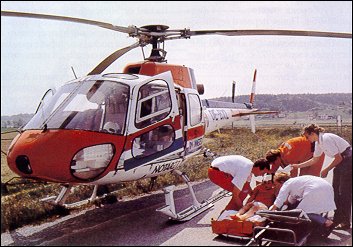
| Aerospatiale/Eurocopter AS.355 Ecureil 2 / AS.555 Fennec 1974 |  |
 |

| Aerospatiale/Eurocopter AS.355 Ecureil 2 / AS.555 Fennec 1974 |  |
 |
|
This is a twin-engined version of the successful AS.350 with the Starflex rotor system and first flew in 1979. Aimed at the large IFR-capable civilian market, the AS.355 was fitted with twin Allison turboshaft engines. After several modifications the latest civilian variant the AS.355F2 is fitted with twin Allison turbines developing around 315kW and new wider composite blades and remoulded engine intakes for anti-icing protection. The French Air Force operate the AS.355N in the surveillance role and later models are fitted with Turbomeca TM319 turbines. P.Allen "The Helicopter", 1996
The need for a light twin-turbine helicopter, particularly in America, led Aerospatiale to develop a bigger version of the Ecureuil — Ecureuil II (or Twinstar) — powered by two 420shp Allison 250-C20F. It made its first flight on 27 September 1979 followed by the second prototype on 13 November. After 122 hours' flight testing, production went ahead at a rate of between five and seven helicopters a month, rising to 20-24 in 1981. G.Apostolo "The Illustrated Encyclopedia of Helicopters", 1984  programme: Twin-engined version of AS 350. First flight of first prototype (F-WZLA) 28 September 1979; details of early production AS 355E/F versions in 1984-85 Jane's; AS 355F superseded by AS 355F1 in January 1984; AS 355F2 certified 10 December 1985; AS 355N powered by two Turbomeca TM 319 Arrius 1A certified in France in 1989, UK and USA in 1992; deliveries of this version began early 1992. CURRENT VERSIONS: Current production AS 355 Ecureuil 2 and AS 555 Fennec are powered by two Turbomeca Arrius 1A turboshafts. AS 355N Ecureuil 2: Current civil production version, adaptable for passengers, cargo, police, ambulance, slung loads, carrying harbour pilots, working on high-tension cables and other missions; Category A OEI performance; known as TwinStar in USA. AS 555UN Fennec: Military utility version and French Army ALAT IFR pilot trainer. AS 555AN Fennec: Armed version; later machines adapted for centreline-mounted 20mm gun and pylon-mounted rockets. AS 555MN Fennec: Naval unarmed version. Can carry a 360° chin-mounted radar. AS 555SN Fennec: Armed naval version for ASW and over-the-horizon targeting, operating from ships of 600 tonnes upwards; armament includes one lightweight homing torpedo or the cannon and rockets of land-based versions; avionics include Honeywell RDR-1500B 360° chin-mounted radar, Thales Nadir 10 navigation system, Thales RDN 85 Doppler and SFIM 85 T31 three-axis autopilot. CUSTOMERS: Total 592 twin-engined Ecureuils in service at May 2000. French Air Force ordered 52 Fennecs, first eight as AS 355F1s powered by Rolls-Royce 250; flown by 67e Escadre d'Helicopteres at Villacoublay and other units for communications and, with side-mounted Giat M61 20mm gun pod, by ETOM 68 in Guyana; delivery of remaining 44 (AS 555AN powered by Arrius) began 19 January 1990; from 24th onwards, provision for centrally mounted 20mm cannon and T-100 sight, plus Mistral missiles; French Army ordered 18 AS 555UNs for TFR training (delivery from February 1992); Brazilian Air Force has 13 AS 555s: 11 with armament, designated CH-55, and two VIP transports, designated VH-55; Brazilian Navy acquired 11 UH-12Bs; Brazilian AS 555s assembled by Helibras in Brazil; four more navies ordered eight AS 555s in 1992, two in 1993, four in 1994 and one in 1995. Two AS 333F1s, leased from OSS of Hayes, UK, supplied to the RAF's No. 32 (The Royal) Squadron at Northolt on 1 April 1996 for VIP transport; third subsequently added. Total of six AS 3555Ns ordered by Malaysian Navy on 13 October 2001 to replace Westland Wasps with deliveries at end 2003. Orders in 1997-2001 totalled nine, 20, 10, 13 and 17. DESIGN FEATURES: Starflex main rotor; two engine shafts drive into combiner gearbox containing freewheels; main rotor turns at 394 rpm and tail rotor at 2,086 rpm; otherwise substantially as AS 350. FLYING CONTROLS: Powered, full dual flying controls without manual reversion; trim by adjustable stick friction; inverted aerofoil tailplane; swept fins above and below tailboom. STRUCTURE: Light metal Tailboom and central fuselage structure; thermoformed plastics for cabin structure. LANDING GEAR: As for AS 350B2/550. POWER PLANT: Two Turbomeca Arrius 1A turboshafts, each rated at 357kW for take-off and 302kW maximum continuous; 388kW 30 minutes OEI emergency; 407kW 2.5 minutes OEI emergency; full authority digital engine control (FADEC) allows automatic sequenced starting of both engines, autnmatic top temperature and torque limiting and preselection of lower limits for practice OEI operation. Transmission rating 511kW for T-O. Two integral fuel tanks, with total usable capacity of 730 litres, in body structure. Optional 475 litre auxiliary tank in cabin. ACCOMODATION: As for single-engined Ecureuil and Fennec. SYSTEMS: As for AS 350B2/550, except two hydraulic pumps, reservoirs and tandem powered flying control units and electric generators. AVIONICS: Options include a second VHF/AM and radio altimeter; provision for IFR system, SFIM 85 T31 three-axis autopilot and CDV 85 T3 nav coupler. EQUIPMENT: Casualty installations, TV, FLIR, searchlight and 204kg capacity winch available. Cargo hook optional; capacity 1,134kg. ARMAMENT (AS 555): Optional alternative weapons include TDA or Forges de Zeebrugge rocket packs, Matra or FN Herstal machine gun pods or a Giat M621 20mm gun. Naval version carries one homing torpedo in ASW role, or SAR winch. Jane's All the World's Aircraft, 2004-2005
- A naval variant, the AS 555MN, is equipped with a chin-mounted radar, but is unarmed. - The first Twin Squirrel made its maiden flight on 28 September 1979. - The Twin Star has the best safety record of any helicopter in its class. - Brazilian company Helibras builds Twin Squirrels with the designation CH-55 and VH-55 for the Brazilian air force. - The Twin Squirrel's FADEC control system allows automatic engine starting. - About 750 Ecureuils and Astars have been delivered to operators in 19 nations.
|